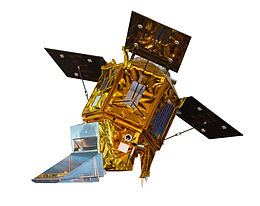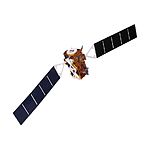
Envisat is a large inactive Earth-observing satellite which is still in orbit and now considered a space debris. Operated by the European Space Agency (ESA), it was the world's largest civilian Earth observation satellite.

XMM-Newton, also known as the High Throughput X-ray Spectroscopy Mission and the X-ray Multi-Mirror Mission, is an X-ray space observatory launched by the European Space Agency in December 1999 on an Ariane 5 rocket. It is the second cornerstone mission of ESA's Horizon 2000 programme. Named after physicist and astronomer Sir Isaac Newton, the spacecraft is tasked with investigating interstellar X-ray sources, performing narrow- and broad-range spectroscopy, and performing the first simultaneous imaging of objects in both X-ray and optical wavelengths.

The Infrared Space Observatory (ISO) was a space telescope for infrared light designed and operated by the European Space Agency (ESA), in cooperation with ISAS and NASA. The ISO was designed to study infrared light at wavelengths of 2.5 to 240 micrometres and operated from 1995 to 1998.

European Remote Sensing satellite (ERS) was the European Space Agency's first Earth-observing satellite programme using a polar orbit. It consisted of 2 satellites, ERS-1 and ERS-2.
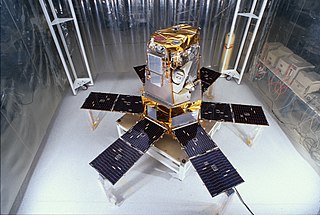
The Solar Radiation and Climate Experiment (SORCE) was a NASA-sponsored satellite mission that measured incoming X-ray, ultraviolet, visible, near-infrared, and total solar radiation. These measurements specifically addressed long-term climate change, natural variability, atmospheric ozone, and UV-B radiation, enhancing climate prediction. These measurements are critical to studies of the Sun, its effect on our Earth system, and its influence on humankind. SORCE was launched on 25 January 2003 on a Pegasus XL launch vehicle to provide NASA's Earth Science Enterprise (ESE) with precise measurements of solar radiation.
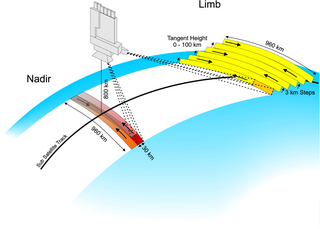
SCIAMACHY was one of ten instruments aboard of ESA's ENVIronmental SATellite, ENVISAT. It was a satellite spectrometer designed to measure sunlight, transmitted, reflected and scattered by the earth's atmosphere or surface in the ultraviolet, visible and near infrared wavelength region at moderate spectral resolution. SCIAMACHY was built by Netherlands and Germany at TNO/TPD, SRON and Dutch Space.

Copernicus is the European Union's Earth observation programme coordinated and managed by the European Commission in partnership with the European Space Agency (ESA), the EU Member States and EU agencies.

The Extreme Ultraviolet Explorer was a NASA for ultraviolet astronomy. EUVE was a part of NASA's Explorer spacecraft series. Launched on 7 June 1992. With instruments for ultraviolet (UV) radiation between wavelengths of 7 and 76 nm, the EUVE was the first satellite mission especially for the short-wave ultraviolet range. The satellite compiled an all-sky survey of 801 astronomical targets before being decommissioned on 31 January 2001.

SRON Netherlands Institute for Space Research is the Dutch expertise institute for space research. The Institute develops and uses innovative technology for research in space, focusing on astrophysical research, Earth science and planetary research. SRON has a line of research into new and more sensitive sensors for X-rays and infrared radiation.

Sentinel-1 is the first of the Copernicus Programme satellite constellation conducted by the European Space Agency. This mission is composed of a constellation of two satellites, Sentinel-1A and Sentinel-1B, which share the same orbital plane. They carry a C-band synthetic-aperture radar instrument which provides a collection of data in all-weather, day or night. This instrument has a spatial resolution of down to 5 m and a swath of up to 400 km. The constellation is on a sun synchronous, near-polar (98.18°) orbit. The orbit has a 12-day repeat cycle and completes 175 orbits per cycle.

Sentinel-2 is an Earth observation mission from the Copernicus Programme that systematically acquires optical imagery at high spatial resolution over land and coastal waters. The mission is currently a constellation with two satellites, Sentinel-2A and Sentinel-2B; a third satellite, Sentinel-2C, is currently undergoing testing in preparation for launch in 2024.
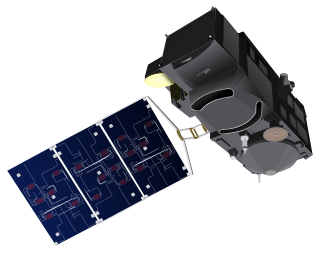
Sentinel-3 is an Earth observation satellite series developed by the European Space Agency as part of the Copernicus Programme. It currently consists of 2 satellites: Sentinel-3A and Sentinel-3B. After initial commissioning, each satellite was handed over to EUMETSAT for the routine operations phase of the mission. Two recurrent satellites— Sentinel-3C and Sentinel-3D— will follow in approximately 2024 and 2028 respectively to ensure continuity of the Sentinel-3 mission.

The Earth and Mission Science Division is a group of European Space Agency (ESA) staff mission scientists, contractors, research fellows, young graduates, trainees, and administrative staff working within the Science, Applications and Climate Department of the Directorate of Earth Observation Programmes. The Division is located at ESA's European Space Research and Technology Centre in Noordwijk, South Holland, The Netherlands.

An X-ray astronomy satellite studies X-ray emissions from celestial objects, as part of a branch of space science known as X-ray astronomy. Satellites are needed because X-radiation is absorbed by the Earth's atmosphere, so instruments to detect X-rays must be taken to high altitude by balloons, sounding rockets, and satellites.

ADEOS I was an Earth observation satellite launched by NASDA in 1996. The mission's Japanese name, Midori means "green". The mission ended in July 1997 after the satellite sustained structural damage to the solar panel. Its successor, ADEOS II, was launched in 2002. Like the first mission, it ended after less than a year, also following solar panel malfunctions.
PRISMA is an Italian Space Agency pre-operational and technology demonstrator mission focused on the development and delivery of hyperspectral products and the qualification of the hyperspectral payload in space.
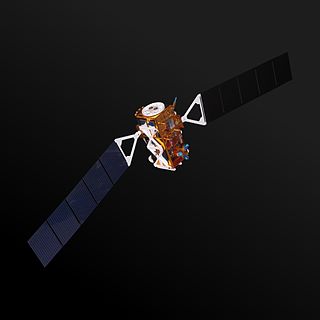
Sentinel-1A is a European radar imaging satellite launched in 2014. It is the first Sentinel-1 satellite launched as part of the European Union's Copernicus programme. The satellite carries a C-band Synthetic Aperture Radar which will provide images in all light and weather conditions. It will track many aspects of our environment, from detecting and tracking oil spills and mapping sea ice to monitoring movement in land surfaces and mapping changes in the way land is used.
Sentinel-4 is a European Earth observation mission developed to support the European Union Copernicus Programme for monitoring the Earth. It focuses on monitoring of trace gas concentrations and aerosols in the atmosphere to support operational services covering air-quality near-real time applications, air-quality protocol monitoring and climate protocol monitoring. The specific objective of Sentinel-4 is to support this with a high revisit time over Europe.

Student Nitric Oxide Explorer, was a NASA small scientific satellite which studied the concentration of nitric oxide in the thermosphere. It was launched in 1998 as part of NASA's Explorer program. The satellite was the first of three missions developed within the Student Explorer Demonstration Initiative (STEDI) program funded by the NASA and managed by the Universities Space Research Association (USRA). STEDI was a pilot program to demonstrate that high-quality space science can be carried out with small, low-cost free-flying satellites on a time scale of two years from go-ahead to launch. The satellite was developed by the University of Colorado Boulder's Laboratory for Atmospheric and Space Physics (LASP) and had met its goals by the time its mission ended with reentry in December 2003.
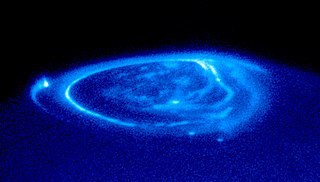
UVS, known as the Ultraviolet Spectrograph or Ultraviolet Imaging Spectrometer is the name of an instrument on the Juno orbiter for Jupiter. The instrument is an imaging spectrometer that observes the ultraviolet range of light wavelengths, which is shorter wavelengths than visible light but longer than X-rays. Specifically, it is focused on making remote observations of the aurora, detecting the emissions of gases such as hydrogen in the far-ultraviolet. UVS will observes light from as short a wavelength as 70 nm up to 200 nm, which is in the extreme and far ultraviolet range of light. The source of aurora emissions of Jupiter is one of the goals of the instrument. UVS is one of many instruments on Juno, but it is in particular designed to operate in conjunction with JADE, which observes high-energy particles. With both instruments operating together, both the UV emissions and high-energy particles at the same place and time can be synthesized. This supports the Goal of determining the source of the Jovian magnetic field. There has been a problem understanding the Jovian aurora, ever since Chandra determined X-rays were coming not from, as it was thought Io's orbit but from the polar regions. Every 45 minutes an X-ray hot-spot pulsates, corroborated by a similar previous detection in radio emissions by Galileo and Cassini spacecraft. One theory is that its related to the solar wind. The mystery is not that there are X-rays coming Jupiter, which has been known for decades, as detected by previous X-ray observatories, but rather why with the Chandra observation, that pulse was coming from the north polar region.
